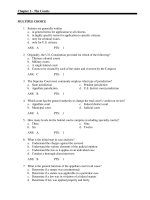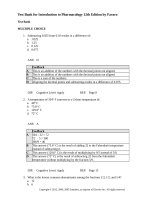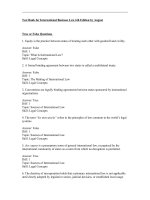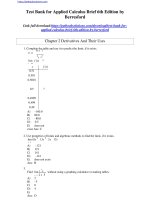Test bank for introduction to law 6th edition by hames
Bạn đang xem bản rút gọn của tài liệu. Xem và tải ngay bản đầy đủ của tài liệu tại đây (446.17 KB, 8 trang )
Test Bank for Introduction to Law 6th Edition by Hames
Full
file at1 />Chapter
Introduction to Law
MULTIPLE CHOICE. Choose the one alternative that best completes the statement or answers the question.
1) Which of the following refers to a set of rules and procedures usually intended to regulate some
aspect of society?
A) Rule
B) Precedent
C) Law
D) Code
1)
2) Which of the following refers to a legal system based primarily on written constitutions and written
laws or codes?
A) Civil law
B) Common law
C) Stare decisis
D) Precedent law
2)
3) Which of the following refers to a body of law developed through the courts?
A) Common law
B) Precedent
C) Civil law
3)
D) Code
4) Which of the following refers to an example set by the decision of an earlier court for similar cases
or similar legal questions that arise in later cases?
A) Precedent
B) Code
C) Standard
D) None of the above
4)
5) Which of the following refers to the study of the philosophy of law?
A) Jurisprudence
B) Legal negativism
C) Legal positivism
D) Legal realism
5)
6) Which of the following refers to a philosophical theory holding that law reflects the moral and
unchangeable laws of nature?
A) Legal Realism
B) Legal positivism
C) Jurisprudence
D) Natural theory of law
6)
7) Which of the following refers to a philosophical theory holding that the validity of law is not
related to morality?
A) Legal positivism
B) Legal Realism
C) Natural theory of law
D) Jurisprudence
7)
8) Which of the following refers to a philosophical theory that laws are created by judges and
therefore subject to individual beliefs and prejudices?
A) Natural theory of law
B) Legal Realism
C) Legal positivism
D) Jurisprudence
8)
9) Which of the following refers to a method for categorizing or classifying laws?
A) Whether the law is criminal or civil
B) Whether the law is substantive or procedural
C) Whether the law is constitutional law, statutory law or case law
D) All of the above
9)
10) Which of the following refers to a non-contractual civil wrong?
A) Offense
B) Tort
C) Fault
D) Regulation
10)
1
Full file at />
Test Bank for Introduction to Law 6th Edition by Hames
Full file at />11) Which of the following define the rights and duties of parties and establish the legal bases for any
lawsuit?
A) Fundamental laws
B) Substantive laws
C) Procedural laws
D) Basic laws
11)
12) Which of the following relate to the enforcement of the substantive rights and duties?
A) Substantive laws
B) Fundamental laws
C) Procedural laws
D) Basic laws
12)
13) Which of the following refers to the procedural rules adopted by all courts regulating practice in
the court?
A) Jurisdiction
B) Due process of court
C) Rules of court
D) None of the above
13)
14) Which of the following refers to the power of authority to act in a certain situation; the power of a
court to hear cases and render judgements?
A) Rules of court
B) Due process of law
C) Jurisdiction
D) All of the above
14)
15) Which of the following refers to an act in violation of a criminal statute?
A) Indigent
B) Act
C) Crime
15)
D) All of the above
16) Which of the following refers to the amount of proof necessary for most civil cases?
A) Probable cause
B) Preponderance of the evidence
C) Beyond a reasonable doubt
D) Burden of proof
16)
17) Which of the following refers to the amount of proof necessary for conviction in a criminal case?
A) Beyond a reasonable doubt
B) Burden of proof
C) Probable cause
D) Preponderance of the evidence
17)
18) Which of the following refers to a finding of responsibility in a civil case?
A) Liable
B) Accountable
C) Guilty
18)
19) Which of the following refers to a finding of not guilty in a criminal case?
A) Innocent
B) Acquittal
C) Nolo contender
D) Responsible
D) Hung jury
20) Which of the following refers to a summary of a Supreme Court case written by the reporter of
decisions?
A) Brief
B) Writ
C) Case law
D) Syllabus
19)
20)
TRUE/FALSE. Write 'T' if the statement is true and 'F' if the statement is false.
21) A set of rules and procedures usually intended to regulate some aspect of society is known as law.
21)
22) The origins and development of laws and legal systems are rarely based on the actions of
government and religion.
22)
23) The term "common law," as used to describe a legal system, refers to a system based primarily on
written constitutions and written laws or codes.
23)
2
Full file at />
Test Bank for Introduction to Law 6th Edition by Hames
Full file at />24) Civil law is a body of laws developed through the courts.
24)
25) Common law systems are those based on the concept of precedent or stare decisis.
25)
26) Natural theory of law is a philosophical theory holding that law reflects the moral and
unchangeable laws of nature.
26)
27) Legal positivism is a philosophical theory holding that the validity of law is not related to morality.
27)
28) Legal realism is a philosophical theory that laws are created by judges and therefore subject to
individual beliefs and prejudices.
28)
29) Laws are categorized in one way: whether the law is constitutional law, statutory law, or case law.
29)
30) Procedural laws define the rights and duties of parties and establish the legal basis for any lawsuit.
30)
31) Substantive laws relate to the enforcement of the substantive rights and duties.
31)
32) Crimes define behavior that society has declared illegal and has decided to punish.
32)
33) Rules of court are laws that are adopted by various courts with power given to the courts by the
legislature.
33)
34) Defendants have a right to due process of law.
34)
35) Jurisdiction is defined as the power or authority to act in a certain situation; the power of a court to
hear cases and render judgments.
35)
36) Beyond a reasonable doubt is defined as the amount of proof necessary for most civil cases; more
likely than not.
36)
37) Preponderance of the evidence is defined as the amount of proof necessary for a conviction in a
criminal case.
37)
38) An acquittal is a finding of not guilty in a criminal case.
38)
39) A hung jury is a jury that cannot attain the necessary consensus or majority to reach a verdict.
39)
40) In a criminal case, the defendant is always the representative of the government.
40)
SHORT ANSWER. Write the word or phrase that best completes each statement or answers the question.
41) ________ refers to rules created and enforced by federal, state, and local governments.
41)
42) Historically, the two major types of legal systems that developed were civil law systems
and ________ systems.
42)
3
Full file at />
Test Bank for Introduction to Law 6th Edition by Hames
Full file at />43) The legal system based primarily on written constitutions and written laws or codes is
known as a(n) ________ system.
43)
44) Common law systems are based on the concept of ________ or "stare decisis."
44)
45) The philosophical theory of law that holds that law reflects the moral and unchangeable
laws of nature is known as the ________ theory of law.
45)
46) The philosophical theory of law that holds that the validity of law is not related to morality
is known as legal ________.
46)
47) One of the ways that laws are ________ is whether the law is constitutional law, statutory
law, or case law.
47)
48) Laws that define the rights and duties of parties and establish the legal basis for any
lawsuit are known as ________ laws.
48)
49) Laws that relate to the enforcement of the substantive rights and duties are known as
________ laws.
49)
50) If the court finds against the defendant in a civil case, the defendant is said to be ________.
50)
4
Full file at />
Test Bank for Introduction to Law 6th Edition by Hames
Full file at />MATCHING. Choose the item in column 2 that best matches each item in column 1.
Match the following.
51) Civil law
52) Common law
53) Code
54) Precedent
55) Legal positivism
56) Legal realism
57) Rules of court
58) Jurisdiction
59) Preponderance of the evidence
60) Beyond a reasonable doubt
A) The example set by the decision of an
earlier court for similar cases or similar
legal questions that arise in later cases.
B) A legal system based on written laws or
codes.
C) The amount of proof necessary for a
conviction in a criminal case.
D) A body of law developed through the
courts.
E) The amount of proof necessary for most
civil cases; more likely than not.
51)
52)
53)
54)
55)
56)
57)
58)
F) A topical organization of statutes.
59)
G) The power or authority to act in a certain
situation; the power of a court to hear
cases and render judgments.
60)
H) Procedural rules adopted by all courts
regulating practice in the court.
I) A philosophical theory holding that the
validity of law is not related to morality.
J) A philosophical theory that laws are
created by judges and therefore subject to
individual beliefs and prejudices.
ESSAY. Write your answer in the space provided or on a separate sheet of paper.
61) Identify and discuss two examples of historical origins of a civil law legal system.
62) Compare and contrast civil law and common law legal systems.
63) Identify and discuss the three major philosophical theories of law.
64) Identify and discuss the three important ways used for categorizing laws.
65) Define "burden of proof" and then compare and contrast the burden of proof in criminal and civil cases.
5
Full file at />
Test Bank for Introduction to Law 6th Edition by Hames
Full file at />66) Does a civil law legal system or a common law legal system provide greater fairness for the average citizen?
Why?
67) Why is the burden of proof different in criminal and civil cases? Should the burden of proof be raised in civil
cases or lowered in criminal cases to make them equal? Explain.
6
Full file at />
Test Bank for Introduction to Law 6th Edition by Hames
Full
file Key
at />Answer
Testname: UNTITLED1
1) C
2) A
3) D
4) A
5) A
6) C
7) A
8) B
9) D
10) B
11) B
12) C
13) C
14) C
15) C
16) B
17) D
18) A
19) B
20) D
21) TRUE
22) FALSE
23) FALSE
24) FALSE
25) TRUE
26) TRUE
27) TRUE
28) TRUE
29) FALSE
30) FALSE
31) FALSE
32) TRUE
33) TRUE
34) TRUE
35) TRUE
36) FALSE
37) FALSE
38) TRUE
39) TRUE
40) FALSE
41) Law
42) common law
43) civil law
44) precedent
45) natural
46) positivism
47) categorized/classified
48) substantive
49) procedural
50) liable
7
Full file at />
Test Bank for Introduction to Law 6th Edition by Hames
Full
file Key
at />Answer
Testname: UNTITLED1
51) B
52) D
53) F
54) A
55) I
56) J
57) H
58) G
59) E
60) C
61) [key points to be made]
Answers will vary, but may include:
• Code of Hammurabi
• Napoleonic Code
62) [key points to be made]
• The term civil law as used to describe a legal system refers to a system based primarily on written constitutions and
written laws or codes. In such legal systems, a ruler or legislative body creates an extensive set of rules or regulations to
govern. The role of courts in such systems is limited.
• Common law systems, on the other hand, are based on precedent or case law.
63) [key points to be made]
• Legal positivism is a philosophical theory holding that the validity of law is not related to morality.
• Natural theory of law is a philosophical theory holding that law reflects the moral and unchangeable laws of
nature.
• Legal realism is a philosophical theory that laws are created by judges and therefore subject to individual beliefs
and prejudices.
64) [key points to be made]
• Whether the law is constitutional law, statutory law, or case law
• Whether the law is substantive or procedural and
• Whether the law is criminal or civil.
65) [key points to be made]
• Burden of proof is the necessity of establishing a particular fact or the necessity of going forward with the evidence.
• Preponderance of the evidence is the amount of proof necessary for most civil cases; more likely than not.
• Beyond a reasonable doubt is the amount of proof necessary for a conviction in a criminal case.
66) Answers will vary.
67) Answers will vary.
8
Full file at />









